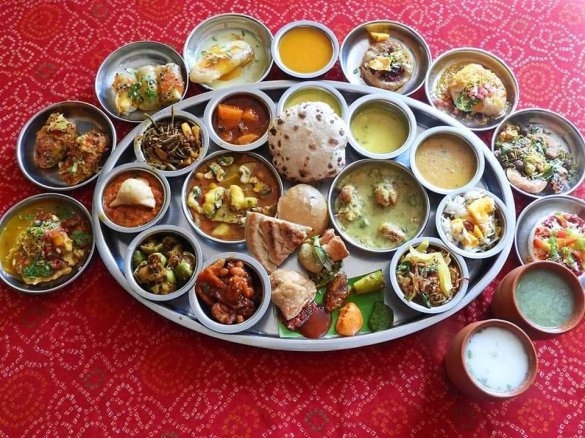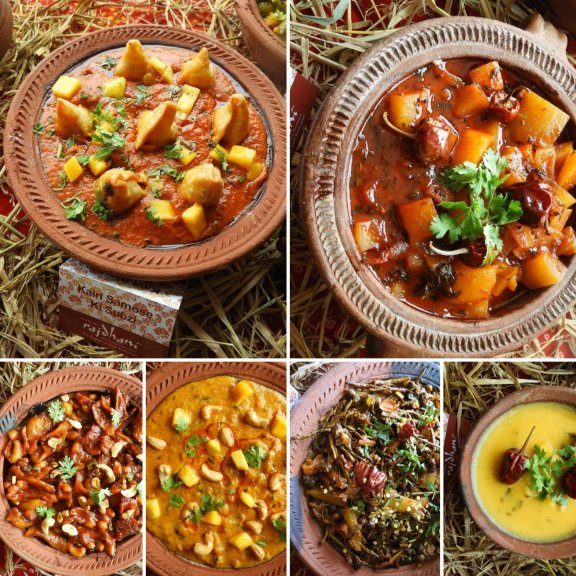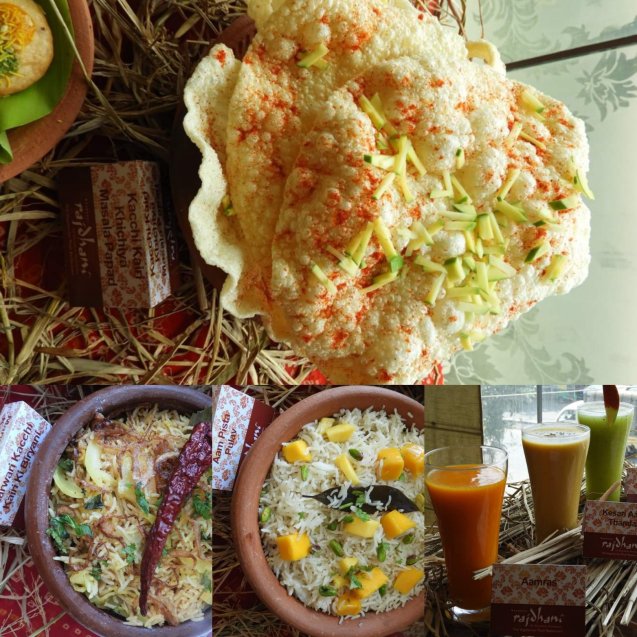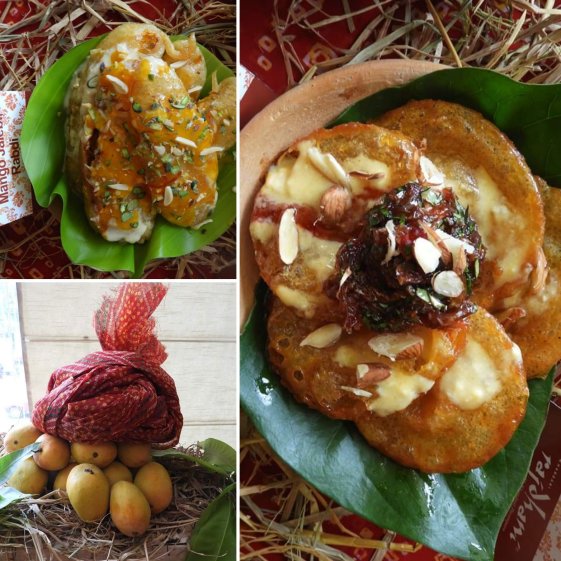A Bengali meal is incomplete without a chutney, especially so on festive occasions. Chutney (rather, ‘Chaatni‘ in the local language) is eaten at the end of a Bengali meal, as a dessert, rather than meaning it to be an accompaniment to the other dishes. It is literally licked off the plate – therefore the name ‘Chaatni‘. And why not? The Bengali Chaatni is, after all, a beautiful medley of flavours sweet and sour with just a hint of spice to keep it intriguing, raisins adding a lovely texture to it. Quite different from the South Indian chutneys we are so used to!
Bengali Chaatnis are also quite intriguing in the sense of what they are made up of. Often, a fruit – think tomato, dried dates, pineapple and mango leather – finds its way into a Chaatni. Then, there’s the one made using raw papaya, called Plastic Chaatni because it resembles shiny plastic in appearance. The recipe I share with you today is for Anarosher Chaatni, pineapple chutney Bengali-style.
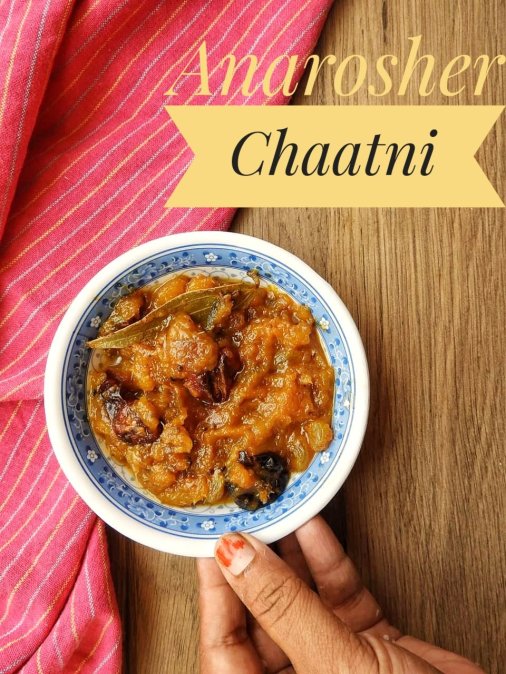
We stayed at a hotel in the New Market area of Calcutta, on a holiday there, a few years ago. It was there that we encountered Chaatni for the first-ever time, and whole-heartedly fell in love with. My interest in Bengali cuisine piqued, I would ask the hotel staff about this dish and that. They were kind enough to enlighten me, and even teach me how to make this Anarosher Chaatni and the gorgeous Bengali Bhoger Khichuri.
I recently recreated this Anarosher Chaatni based on recollections of passionate foodie conversations with those hotel staff of a few years past. It was a huge hit, with everyone at home loving it to bits. It was licked clean within minutes – I kid you not! I served it alongside rotis and cabbage sabzi, and it made for a wonderful accompaniment. Spiced with panch phoron, this pineapple chutney, Bengali style, jazzed up our meal like no one’s business!
This chutney is such a simple affair, but an absolute treat to the senses! I have made it with minimal jaggery (rather than sugar) and oil. It is entirely plant-based, vegan and gluten-free by its very nature. Come to think of it, this low-oil Anarosher Chaatni would make for a relatively healthy vegan dessert treat as well!
Let us now check out the recipe for this Pineapple Chutney, Bengali Style, shall we?
Ingredients (makes 1 cup):
- 1 heaped cup of chopped ripe pineapple, thorns removed
- 2 teaspoons oil
- 1 teaspoon panch phoron or Bengali five-spice mix
- 2 small bay leaves
- 2 dried red chillies
- 1 tablespoon raisins
- A pinch of salt
- 1/4 teaspoon turmeric powder
- 2 tablespoons jaggery powder or to taste
- A dash of red chilli powder or to taste
- 1 teaspoon roasted cumin powder
Method:
1. Take the chopped pineapple in a large, wide vessel. Add in a little water. Place the vessel in a pressure cooker and cook for 3 whistles on high flame. Switch off gas and allow the pressure to come down naturally.
2. Allow the cooked pineapple to cool down fully. Then, grind it coarsely in a mixer, along with the water it was cooked in.
3. Heat the oil in a pan. Add in the panch phoron, dried red chillies and bay leaves. Let the ingredients stay in for a couple of seconds.
4. To the pan, add the coarse pineapple puree. Add salt, red chilli powder, turmeric powder, raisins and jaggery powder. Mix well.
5. Turn the flame down to medium. Cook the mixture on medium flame till the chutney thickens slightly, 3-4 minutes. Switch off gas when it is still quite runny, for it thickens further on cooling. Now, mix in the roasted cumin powder.
6. Allow the chutney to cool down fully before transferring it to a clean, dry, air-tight box. Store refrigerated.
Notes:
1. Panch phoron is a Bengali-style mix of five spices – cumin, mustard, fennel, fenugreek and nigella seeds. You can make your own panch phoron or buy a ready-to-use packet – it is commonly available in most departmental stores. I use a store-bought version that I am quite happy with.
2. A lot of Bengali families use sugar in their chaatni. I have used jaggery here, instead, to make the dish healthier.
3. Adjust the quantity of sugar/jaggery depending upon how sweet the pineapple is.
4. Adjust the quantity of red chilli powder, salt and other spices as per personal taste preferences.
5. For best results, use a ripe, juicy, sweet pineapple that is not overly sour. Make sure all thorns are removed before using the pineapple in the Anarosher Chaatni.
6. I have coarsely pulsed the cooked pineapple here, so I got a mix of puree and pieces of the fruit. This lent a very interesting texture to the chaatni. You could keep the pineapple pieces whole or make a fine puree, as you please.
7. Make sure the pineapple is cooked fully, before using it in making the chaatni.
8. Switch off the gas when the Anarosher Chaatni is still quite runny. It is supposed to be runny, and thickens a bit on cooling as well.
9. I have used refined oil to make the Anarosher Chaatni, as opposed to the pungent mustard oil that is typically used in most Bengali cooking.
******************
This post is for the Foodie Monday Blog Hop, a Facebook group that I am part of. Every Monday, a bunch of us food bloggers present dishes based on a pre-determined theme.
The theme this week is #BengaliFoodFest, wherein we are cooking dishes from the vast Bengali cuisine. The theme was suggested by Sujata Roy, who writes at Batter Up With Sujata.
I’m also sharing this recipe with Fiesta Friday #273. The co-host this week is Mollie @ The Frugal Hausfrau.


